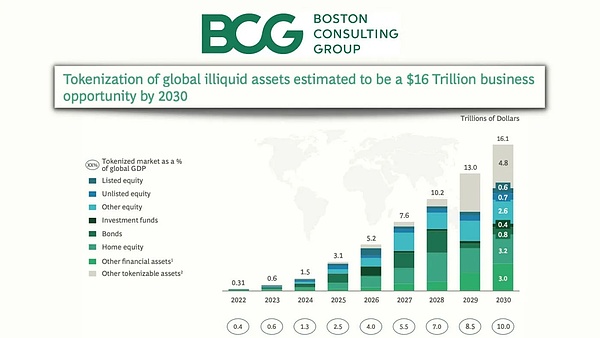
Author: Mark Dewolf; Source: Plain Language Blockchain
Have you ever fantasized about having something rare, precious, beyond the reach of ordinary people? A painting by Picasso, a 200-carat gem, Jimmy Hendrix used guitar – these out-of-reach treasures are digitized and divided into ownership, thus becoming within reach by tokenizing real-world assets (RWA).
Tokenization is not only suitable for historical treasures. Traditional investment fields, such as real estate and stocks, are also being quickly incorporated into the decentralized finance (DeFi) ecosystem, revolutionizing the way they own, manage and trade.
Boston Consulting Group estimates that the cumulative value of tokenized RWA could reach $16 trillion by 2030, while standard chartered banks believe $30 trillion is also possible.
Now, the world's largest asset management company, has launched tokenized US Treasury products. Mainstream adoption seems to be a foregone conclusion and its impact has begun to emerge.
01 Why tokenized RWA performs better than crypto marketThe principle of tokenization of real-world assets is not difficult to understand: converting physical assets such as art, real estate, precious metals or collectibles into virtual investment tools on the blockchain.
Rather than writing a house deed or certificate of authenticity on paper, it is better to record ownership and proof of authenticity on the chain. These assets can then be traded between counterparties or sold separately, giving more people partial ownership.
Credit: Boston Consulting Group
This concept is rapidly heating up. In 2024, Ondo Finance's governance token ONDO grew by more than 550% this year, while Mantra Chain's native token OM soared by 2100%. Both tokens have market capitalizations of over $1 billion, solidifying themStatus in the top 100 cryptocurrencies.
They are favored by investors, due to their usefulness and the convenience of providing traders with access to DeFi returns.
Ondo's earnings tokenized product USDY allows investors around the world to easily access short-term US Treasury bonds, with less than five minutes of registration - almost unheard of in DeFi's cumbersome and technically complex user experience.
Mantra's platform is committed to providing similar services to institutions, making the process of issuing, listing and trading RWA more like investing in real estate and corporate bonds in a compliant environment.
The platform recently partnered with Dubai real estate developer MAG Group to tokenize $500 million in real estate assets.
02 Why is RWA tokenization so popular?Although RWA tokenization did not attract the attention of mainstream media until last year, tokenization itself is inseparable from blockchain technology. Pritam Dutta, founder and CEO of Zoth, said in an interview with Bloomberg: "The increased regulatory transparency and the approval of spot Bitcoin ETFs have enhanced the confidence of traditional financial players in institutions." In July 2024, BlackRock's tokenized U.S. Treasury bond product BUIDL exceeded US$500 million in less than five months after its launch.
Franklin Templeton joined the field after BlackRock, and Goldman Sachs announced plans to launch three tokenized products this year.
Oh Thongsrinoon, chief marketing officer of fashion meta-universe company ALTAVA, said at an industry conference in August 2024 that DeFi's innovations make tokenized assets more credible and reliable.
Tom Wan, assistant digital asset strategy at crypto asset manager 21.co, said on Twitter last year that decentralized autonomous organizations (DAOs) are using this reliability to diversify their portfolios from volatile crypto assets toward diversification.
DAI stablecoin issuer Sky (formerly MakerDAO), plans to take this trend to new heights by introducing up to $1 billion in tokenized U.S. Treasury bonds and other similar products.
Now, crypto investors see Sky as a representative of RWA tokenization. Its governance token MKR hit a nearly three-year high in mid-2024, thanks to diversification by increasing U.S. Treasury bonds as collateral for DAI stablecoins.
In August 2024, MKR rose more than 70% this year, outperforming big-name assets such as Bitcoin (53% up this year) and Ethereum (51% up this year). This highlights the popularity of the RWA tokenization narrative.
03 The future of surpassing Treasury bondsWhat will RWA tokenization look like in 2025? ALTAVA's Thongsrinoon believes that democratized access to previously poor liquid and high-value assets will bring tokenized real estate, commodities and private equity to a great deal of attention.
"These asset classes provide high returns and diversification potential, attractive to institutional customers and retail users. ”
Zoth's Prittam Dutta said in an interview with Reuters that he expects the Federal Reserve system's interest rate cut cycle this year to weaken the attractiveness of tokenized U.S. Treasuries due to lower yields.
He added that this could make tokenized corporate bonds shine, which is one of the reasons Zoth is about to launch tokenized liquid notes that include corporate bonds and short-term Treasuries.
"In a low-interest rate environment, corporate bonds are particularly attractive as high-quality yield alternatives, especially as the Federal Reserve hints that interest rate cuts may be cut later this year. ”
04 SummaryCitigroup's analysis released at its 10th Digital Currency Symposium pointed out that tokenization provides investors with the ultimate application of cryptocurrency and blockchain.
"Almost anything valuable can be tokenized, and the tokenization of financial assets and real-world assets may be the killer use case required for blockchain to achieve breakthroughs. ”
Cryptocurrencies have long been criticized for not finding the right product market fit. With the addition of some of the world's largest traditional financial institutions, RWA tokenization may change that narrative.











